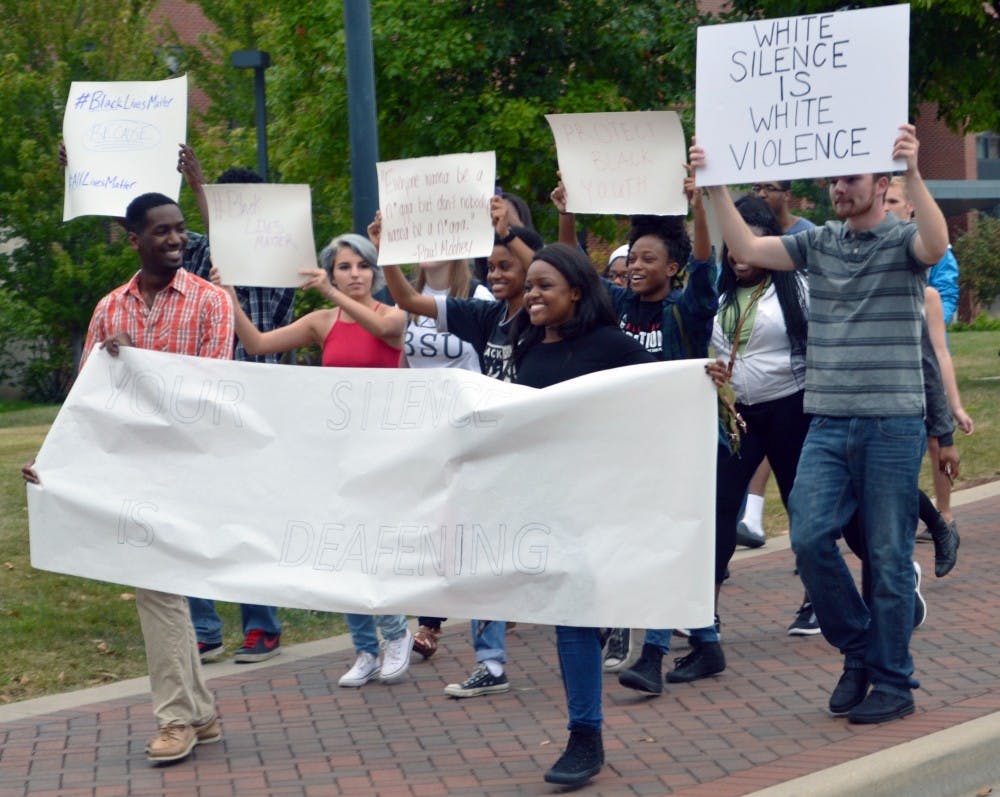Searching for signatures in the cold, stripping down and being written on outside the library, and marching around campus. These student groups won’t just sit around–they are taking action.
The coat-clad figures huddled near, though their mood was brighter than the steel gray sky. Each took a bundle of leaflets and trotted off in opposite directions. Early November meant the creeping cold arrived. Tonight it hovered just above freezing. But the group “Muncie for Bernie Sanders” endured the chill in the air for a chance to vote for their favorite presidential candidate.
The golden McDonald’s arch at the corner of East Charles and South Madison streets loomed merrily ahead. Michael Mahoney and Adam Stant, two of the group’s leaders, crossed from the brightly lit downtown blocks into relative darkness.
“This is just to get Bernie Sanders on the ballot to run against Hillary Clinton,” said Michael. “I always tell people ‘sign if you want more choices.’ That usually works.”
Nearby, Michael knocked on a door and waited. After speaking for a few minutes on the porch, he stepped inside for a while before returning.
“Did you get one?”
“Two. His wife signed as well.”
To appear on the ballot for the primary election, each candidate is required to get 500 valid signatures from each district in the state. The canvassers continued to another block, around the corner from Muncie Power Products. This time Adam had to do some talking. The porchlight spilled across the pillars and on to the street as he made his point. Finally, the woman took the clipboard and signed.
“What convinced her?”
“The Fight for Fifteen,” he said. “She asked ‘Why are you out here freezing? Where is Bernie Sanders?” Adam said the nature of that question tells him everything he needs to know about the state of politics in the 2016 race.
Detachment has arguably sank deep into American culture, but activists like those of “Muncie for Bernie Sanders” stand determined against it. The politically or socially involved face an uphill battle, even with the twenty-first century’s cheap and efficient organizing tools.
In 2008 and 2012, the United States saw voter turnouts of 58.23 and 54.87 percent respectively of the voting age population. On non-presidential years, state elections are even more abysmal. Indiana had 30 percent voter turnout in 2014, according to state sources.
Voter turnout for presidential elections peaked all the way back in 1876, when Rutherford B. Hayes beat Samuel J. Tilden in the wake of America’s civil war. Few Americans likely have strong feelings about that race these days, but the controversial election drew 81.1 percent of the voting age population at the time.
Neither man got the majority in the electoral college and the voting stood contested in Oregon, Louisiana, Florida, and South Carolina. So it fell to congress to decide. In what’s known as “The Bargain of 1877,” a 15-person electoral committee confirmed Hayes as president.
Tilden won the popular vote by roughly 250,000. But that isn’t what determines the office.
Hayes wasn’t the first or last president to win in such a way. In 1824, 1876, 1888, and 2000, a candidate won that most voters did not endorse.
Even if Americans seem disillusioned with the fruits of their ballot, organized action continues anyway. Across Muncie, various activist groups have mobilized. Using low overhead tools and tactics, they’re raising awareness, cultivating a base and engaging in action. Not all of it is strictly politics, however.
To continue reading, visit BallBearingsMag.com





